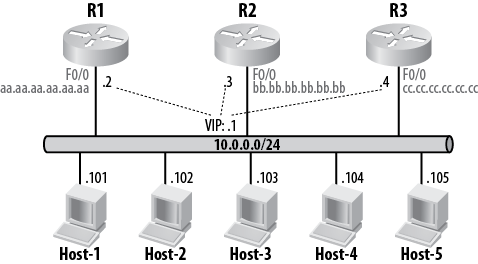GLBP
GLBP (Gateway Load Balancing Protocol) is similar to HSRP and VRRP, but with the addition of load balancing between group members. With HSRP and VRRP, there is only one active member, while the other member or members forward no traffic. With GLBP, each member may forward traffic and can even be weighted. Weighting the gateway members allows you to have, for example, three gateways active with 50% of traffic going to one and 25% going to each of the other two. You can have a maximum of 1,024 GLBP groups per router interface with up to four virtual forwarders per group. Letâs look at an example.
Figure 13-7 shows a simple network containing five hosts with three routers. Each of these three routers will participate in GLBP, and we will actively forward traffic through all three. Weâll configure R1 to take 50% of the load, while R2 and R3 will take 25% each.

Figure 13-7. GLBP example network
Gateways configured with GLBP are called forwarders. Any router that is forwarding packets is called an Active Virtual Forwarder (AVF). One of the routers will be elected as the Active Virtual Gateway (AVG). The AVG has the responsibility for controlling the group and essentially being the brain of the operations. The AVG will control the load-balancing operations, respond to ARP requests, and assign virtual MAC addresses to AVFs. Be careful with terminology here, because the term active ...
Get Network Warrior, 2nd Edition now with the O’Reilly learning platform.
O’Reilly members experience books, live events, courses curated by job role, and more from O’Reilly and nearly 200 top publishers.

